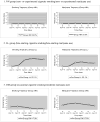Maternal predictors of comorbid trajectories of cigarette smoking and marijuana use from early adolescence to adulthood
- PMID: 21968229
- PMCID: PMC3196799
- DOI: 10.1016/j.addbeh.2011.09.004
Maternal predictors of comorbid trajectories of cigarette smoking and marijuana use from early adolescence to adulthood
Abstract
This is the first study to examine maternal predictors of comorbid trajectories of cigarette smoking and marijuana use from adolescence to adulthood. Participants (N=806) are part of an on-going longitudinal psychosocial study of mothers and their children. Mothers were administered structured interviews when participants were adolescents, and participants were interviewed at six time waves, from adolescence to adulthood. Mothers and participants independently reported on their relationships when participants were X¯ age 14.1 years. At each time wave, participants answered questions about their cigarette and marijuana use from the previous wave to the present. Latent growth mixture modeling determined the participants' membership in trajectory groups of comorbid smoking and marijuana use, from X¯ ages 14.1 to 36.6 years. Multivariate logistic regression was used to assess the association of maternal factors (when participants were adolescents) with participants' comorbid trajectory group membership. Findings showed that most maternal risk (e.g., mother-child conflict, maternal smoking) and protective (e.g., maternal affection) factors predicted participants' membership in trajectory groups of greater and lesser comorbid substance use, respectively. Clinical implications include the importance of addressing the mother-child relationship in prevention and treatment programs for comorbid cigarette smoking and marijuana use.
Copyright © 2011 Elsevier Ltd. All rights reserved.
Figures

The cigarette smoking measure at each time point was: 0=none, 1=less than daily, 2=1–5 cigarettes a day, 3=about half a pack a day, 4=about a pack a day, and 5=about 1.5 packs a day or more;
The marijuana use measure at each time point was: 0=none, 1=a few times a year or less, 2=once a month, 3=several times a month, 4=once a week, 5=several times a week, and 6=every day.
NN group: mean BPP=94%, min. BPP=49%, max. BPP=100%; LL group: mean BPP=92%, min. BPP=28%, max. BPP=100%; OM group: mean BPP=91%, min. BPP=48%, max. BPP=100%; HO group: mean BPP=91%, min. BPP=49%, max. BPP=100%; HH group: mean BPP=90%, min BPP=45%, max BPP=100%.

The cigarette smoking measure at each time point was: 0=none, 1=less than daily, 2=1–5 cigarettes a day, 3=about half a pack a day, 4=about a pack a day, and 5=about 1.5 packs a day or more;
The marijuana use measure at each time point was: 0=none, 1=a few times a year or less, 2=once a month, 3=several times a month, 4=once a week, 5=several times a week, and 6=every day.
NN group: mean BPP=94%, min. BPP=49%, max. BPP=100%; LL group: mean BPP=92%, min. BPP=28%, max. BPP=100%; OM group: mean BPP=91%, min. BPP=48%, max. BPP=100%; HO group: mean BPP=91%, min. BPP=49%, max. BPP=100%; HH group: mean BPP=90%, min BPP=45%, max BPP=100%.
Similar articles
-
Longitudinal trajectories of marijuana use from adolescence to young adulthood.Addict Behav. 2015 Jun;45:301-8. doi: 10.1016/j.addbeh.2015.02.008. Epub 2015 Feb 18. Addict Behav. 2015. PMID: 25792233 Free PMC article.
-
Developmental trajectories of marijuana use from adolescence to adulthood: personal predictors.Arch Pediatr Adolesc Med. 2011 Jan;165(1):55-60. doi: 10.1001/archpediatrics.2010.248. Arch Pediatr Adolesc Med. 2011. PMID: 21199981 Free PMC article.
-
Course of comorbidity of tobacco and marijuana use: psychosocial risk factors.Nicotine Tob Res. 2010 May;12(5):474-82. doi: 10.1093/ntr/ntq027. Epub 2010 Mar 15. Nicotine Tob Res. 2010. PMID: 20231241 Free PMC article.
-
Prospective Predictors of Novel Tobacco and Nicotine Product Use in Emerging Adulthood.J Adolesc Health. 2015 Aug;57(2):186-91. doi: 10.1016/j.jadohealth.2015.04.015. J Adolesc Health. 2015. PMID: 26206439 Free PMC article.
-
Developmental trajectories of adolescent cannabis use and their relationship to young adult social and behavioural adjustment: A longitudinal study of Australian youth.Addict Behav. 2016 Feb;53:11-8. doi: 10.1016/j.addbeh.2015.09.008. Epub 2015 Sep 21. Addict Behav. 2016. PMID: 26414206
Cited by
-
Predictors of onset of cannabis and other drug use in male young adults: results from a longitudinal study.BMC Public Health. 2014 Nov 22;14:1202. doi: 10.1186/1471-2458-14-1202. BMC Public Health. 2014. PMID: 25416140 Free PMC article.
-
Trajectories of substance use among young American Indian adolescents: patterns and predictors.J Youth Adolesc. 2014 Mar;43(3):437-53. doi: 10.1007/s10964-013-0026-2. Epub 2013 Oct 18. J Youth Adolesc. 2014. PMID: 24136376 Free PMC article.
-
Trajectories of pre- and postnatal co-use of cannabis and tobacco predict co-use and drug use disorders in adult offspring.Neurotoxicol Teratol. 2018 Nov-Dec;70:10-17. doi: 10.1016/j.ntt.2018.09.002. Epub 2018 Sep 15. Neurotoxicol Teratol. 2018. PMID: 30227199 Free PMC article.
-
Associations between parenting characteristics and adolescent substance use: A genetically informed, longitudinal adoption study.Dev Psychopathol. 2022 Dec;34(5):1702-1715. doi: 10.1017/S0954579422000748. Epub 2022 Aug 15. Dev Psychopathol. 2022. PMID: 35968857 Free PMC article.
-
Predictors of co-occurring risk behavior trajectories among economically disadvantaged African-American youth: contextual and individual factors.J Adolesc Health. 2014 Sep;55(3):380-7. doi: 10.1016/j.jadohealth.2014.02.023. Epub 2014 Apr 19. J Adolesc Health. 2014. PMID: 24755141 Free PMC article.
References
-
- Avgar A, Bronfenbrenner U, Henderson CR., Jr Socialization practices of parents, teachers, and peers in Israel: kibbutz, moshav, and city. Child Development. 1977;48:1219–1227.
-
- Berenson KR, Crawford TN, Cohen P, Brook J. Implications of identification with parents and parents’ acceptance for adolescent and young adult self-esteem. Self and Identity. 2005;4:289–301.
-
- Brook JS, Brook DW, Gordon AS, Whiteman M, Cohen P. The psychosocial etiology of adolescent drug use: A family interactional approach. Genetic, Social, and General Psychology Monographs. 1990;116:111–267. - PubMed
-
- Brook JS, Whiteman M, Gordon AS, Cohen P. Some models and mechanisms for explaining the impact of maternal and adolescent characteristics on adolescent stage of drug use. Developmental Psychology. 1986;22:460–467.
Publication types
MeSH terms
Grants and funding
LinkOut - more resources
Full Text Sources
Medical

